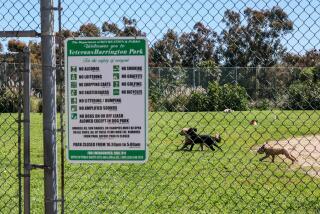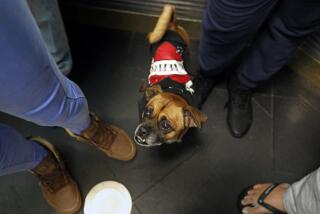Doggy gentrification
COYOTES MAY have invaded the otherwise orderly confines of Hancock Park adjacent, but where I live, in Echo Park, we’ve got an even more vexing problem: domestic dogs.
Like their wild cousins, certain canine pets in this neighborhood see fit to strut around as if they own the place. You will find them trotting down thoroughfares, sunning themselves in the middle of winding streets and gathering at the public water bowl in Elysian Park with the proprietary clubbiness of AA members at their favorite coffee shop. Some of these dogs have temporarily wandered away from responsible owners, some are strays and some fall into an in-between category that’s not uncommon in gentrifying neighborhoods like mine. That is to say, the humans who are ostensibly in charge of the dogs have ideas about their care that don’t exactly jibe with the values of the “gentry” who are moving in and remaking the neighborhood.
There are lots of dogs in Echo Park, the majority of which are cared for responsibly and lovingly by owners of every race and socioeconomic level. But to walk down our streets is to be all too familiar with the sight of pit bulls on chains, rangy mutts roaming the streets without tags and stir-crazy hounds barking psychotically behind fences. The ante is upped by our proximity to Elysian Park, which makes the area a prime spot for animal abandonment.
To combat some of this, we have a neighborhood animal alliance made up of volunteers who work with residents, shelters and the Department of Animal Care & Control to get strays off the streets, procure spaying and neutering vouchers for owners who can’t afford it and even help the homeless to better care for their dogs. The alliance maintains an online message board designed to help find homes for displaced pets and share advice about things like veterinarians and pet-sitters. As well-intended and helpful as these dialogues usually are, they also provide telling clues about the unspoken truths of the gentrification wars.
Issues of race or class are never mentioned outright, but the postings are often filled with enraged chatter about who needs to be “educated” about proper pet care. And what everyone knows but won’t say out loud is that nearly every member of the rescue group is middle class and white and nearly every negligent owner they “monitor” is poor or working class — and probably Latino.
I am a de facto member of this group. After all, I’m a white, middle-class person who reads the boards, can be ridiculously overprotective of my (90-pound) dog and has on more than one occasion jumped out of the car on Sunset Boulevard to snatch a wayward pooch from harm’s way.
Recently, I joined forces with some alliance members to intervene with two dogs who’d been allowed to make the whole neighborhood their personal playground.
In one case, the owners didn’t much care about the hole in their fence because the puppy had grown too big and, they told me, “we want to get rid of him.” In the other, the dog’s owners had moved away and simply left it outside the empty house. Within a month, we had the dogs neutered, renamed (one had originally been called “Trouble,” which was thought to hurt his chances for adoption) and squired off to foster homes. We’re still trying to find them permanent homes, preferably out of the neighborhood for fear the park will lure them back to their wandering ways (for the record, they’re good dogs and, ahem, my e-mail address is at the end of this column).
But as much as I knew that getting these pups off the street was the right thing to do, this particular rescue mission made me feel less like a good Samaritan and more like a crazy dog lady. That’s because unlike dogs that are tethered to chains day in, day out, or that suffer violent abuse (whose owners I wish I could send to jail), these dogs seemed far from unhappy. They spent their days bounding up and down the hill to the park, accepting treats from neighbors and enjoying more of the natural world in one day than my dog sees in a month. Granted, that could be an unsafe situation for them and the humans, particularly children, who walk our streets. But they had a spirit you just don’t see in dogs that are “privileged” enough to live behind secure fences or sleep inside houses. Freed from the emotional burden of being pets, they had been given the great gift of simply being dogs.
Is that a concept that the poor understand better than the affluent? Where do we draw the line between concern for animals and cultural intolerance, between altruism and imperialism, between good citizenship and crazy dog-lady-dom?
I don’t know, but I do know that humans aren’t the only ones displaced and discomfited by gentrification. Animals must learn to play by new rules too. My only hope is that they’ll forgive us, because I sure don’t expect their owners to.
mdaum@latimescolumnists.com
More to Read
Sign up for Essential California
The most important California stories and recommendations in your inbox every morning.
You may occasionally receive promotional content from the Los Angeles Times.











